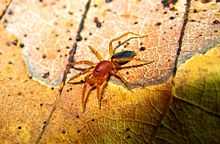Nops (spider)
| Nops | |
|---|---|
 | |
| Nops guanabacoae male, Cuba | |
| Scientific classification | |
| Kingdom: | Animalia |
| Phylum: | Arthropoda |
| Class: | Arachnida |
| Order: | Araneae |
| Family: | Caponiidae |
| Genus: | Nops MacLeay, 1839 |
| Species | |
|
see article | |
| Diversity | |
| 28 species | |
Medium-sized caponiids with only two eyes. The genus currently counts 27 extant species plus one fossil in Dominican amber, but probably the real number of extant species is greater.[1] Nops have a great richness on the Caribbean islands (14 species). Even species of Central America (4) and South America (15) are located in high proportion toward the area of the Caribbean Sea. Most species of South America are known only from the coast of Colombia and Venezuela, including the islands of Aruba, Curaçao, Bonaire and Trinidad.[2] The genus is not revised yet, but apparently have a Neotropical distribution.
Species
Nops MacLeay, 1839
- Nops anisitsi Strand, 1909 — Paraguay
- Nops ariguanabo Alayón, 1986 — Cuba
- Nops bellulus Chamberlin, 1916 — Peru
- Nops blandus (Bryant, 1942) — Hispaniola, Puerto Rico, Virgin Is.
- Nops branicki (Taczanowski, 1874) — French Guiana
- Nops coccineus Simon, 1891 — St. Vincent
- Nops craneae Chickering, 1967 — Trinidad
- Nops enae Sánchez-Ruiz, 2004 — Cuba
- Nops ernestoi Sánchez-Ruiz, 2005 — Hispaniola
- Nops farhati Prosen, 1949 — Argentina
- Nops flutillus Chickering, 1967 — Curaçao
- Nops gertschi Chickering, 1967 — Hispaniola
- Nops glaucus Hasselt, 1887 — Venezuela, Bonaire
- Nops guanabacoae MacLeay, 1839 — Cuba
- Nops largus Chickering, 1967 — Panama
- Nops maculatus Simon, 1893 — Panama
- Nops mathani Simon, 1893 — Brazil
- Nops meridionalis Keyserling, 1891 — Brazil
- Nops nitidus Simon, 1907 — Brazil
- Nops proseni Birabén, 1954 — Argentina
- Nops siboney Sánchez-Ruiz, 2004 — Cuba
- Nops simla Chickering, 1967 — Panama, Trinidad
- Nops sublaevis Simon, 1893 — Venezuela
- Nops toballus Chickering, 1967 — Jamaica
- Nops ursumus Chickering, 1967 — Panama
- Nops variabilis Keyserling, 1877 — Colombia, Brazil
- Nops virginicus Sánchez-Ruiz, 2010 — Virgin Is.
Monophyly
Nops is a nopinae genus (i.e., have subsegmeted tarsi). These caponiids spiders show two other unusual leg characters that are often found in nopine genera: the ventral translucent keel on the anterior metatarsi, and the translucent extension of the membrane between the anterior metatarsi and tarsi. However, these species differ from the other nopines with these leg modifications in having an elongated unpaired claw on anterior legs, extending dorsally between the paired claws (see [3][4][5] and [6]
Image gallery
-

Nops craneae Chickering, carapace
-

Nops enae Sánchez-Ruiz
-

Nops guanabacoae MacLeay, female with egg sac
-

Nops guanabacoae MacLeay, male
-

Nops guanabacoae MacLeay, claws on leg I
-

Nops guanabacoae MacLeay, tarso of leg I
-

Nops siboney Sánchez-Ruiz, ventral view
References
- ↑ Sánchez-Ruiz, A. (2004) Current taxonomic status of the family Caponiidae (Arachnida, Araneae) in Cuba with the description of two new species. Revista Ibérica de Aracnología 9: 95-102.
- ↑ Platnick, N. I. (2013) The world spider catalog, version 14.0. American Museum of Natural History, online at http://research.amnh.org/entomology/spiders/catalog/index.html
- ↑ Sánchez-Ruiz, A. (2004) Current taxonomic status of the family Caponiidae (Arachnida, Araneae) in Cuba with the description of two new species. Revista Ibérica de Aracnología 9: 95-102.
- ↑ Jiménez, M. L., N. I. Platnick & N. Dupérré (2011) The haplogyne spider genus Nopsides (Araneae, Caponiidae), with notes on Amrishoonops. American Museum Novitates 3708: 1-18.
- ↑ Sánchez-Ruiz, A. (2010) Una nueva especie del género Nops Macleay, 1839 (Araneae, Caponiidae) procedente de Islas Vírgenes de Estados Unidos de América, Antillas Menores. Novitates Caribaea 3: 22-31.
- ↑ Sánchez-Ruiz, A., N.I. Platnick, and N. Dupérré (2010). A new genus of the spider family Caponiidae (Araneae, Haplogynae) from the West Indies. American Museum Novitates 3705: 1–44.